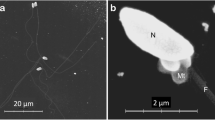Abstract
Variation in cod stock strength in the Baltic Sea is considered to be dependent on abiotic conditions such as salinity and water oxygen content in the spawning areas (the Baltic deep basins). Spawning cod were caught off northern Gotland, Sweden, from April to June in 1989 and 1990. Our investigation revealed a reduction in spermatozoan motility and a subsequent reduction in the percentage of fertilized eggs in salinities of 10 to 12‰. Normal egg development required a minimum salinity of 11‰. This coincides with the osmolality of the seminal plasma and egg yolk; i.e., the Baltic cod is adapted to hyperosmotic conditions for spawning and is thus totally dependent on periodical inflows of saline water from the North Sea.
Similar content being viewed by others
Literature cited
Davenport, J., Lonning, S., Kjorsvik, E. (1981). Osmotic and structural changes during early development of eggs and larvae of the cod,Gadus morhua. J. Fish biol. 19: 317–331
Fletcher, C. R. (1978). Osmotic and ionic regulation in the cod (Gadus morhua). J. comp. Physiol. 124: 149–155
Grauman, G. B. (1973). Investigations of factors influencing fluctuations in abundance of Baltic cod. Rapp. P.-v. Réun. Cons. int. Explor. Mer 164: 73–76
Hansson, S., Rudstam, L. G. (1990). Eutrophication and Baltic fish community. Ambio 19: 123–125
Hohendorf, K. (1968). Zur Schwebfähigkeit pelagischer Fischeier in der Ostsee. Ber. dt. wiss. Kommn Meeresforsch. 19: 181–193
Kändler, R. (1944). Untersuchungen über den Ostseedorsch während der Forschungsfahrten mit dem R.F.D. „Poseidon“ in den Jahren 1925–1938. Ber. dt. wiss. Kommn Meeresforsch. (Neue Folge) 11 (2): 137–245
Lebedek, W. (1978). Occurrence and distribution of sprat and cod eggs and larvae in the sourthern Baltic in 1977. Int. Counc. Explor. Sea Comm. Meet. (Baltic fish Comm.) J: 15: 1–4
Mangor-Jensen, A. (1987). Water balance in developing eggs of the cod Gadus morhua. In: Fish physiology and biochemistry, Vol. 3. Kugler Publications, Amsterdam/Berkeley, p. 17–24
Modin, J. (1987). A note on large catches of cod,Gadus morhua, in the Bothnian sea during spring 1987. Int. Counc. Explor. Sea Comm. Meet. (Baltic Fish Comm.) J: 26: 1–4
Morisawa, M., Suzuki, K. (1980). Osmolality and potassium ion: their roles in initiation of sperm motility in teleosts. Science, N.Y. 210: 1145–1146
Mork, J., Ryman, N., Ståhl, G., Utter, F., Sundnes, G. (1985). Genetic variations in cod (Gadus morhua): little divergence throughout its range. Can. J. Fish. aquat. Sciences 42: 1580–1587
Otterlind, G. (1984a). On fluctuations of the Baltic cod stock. Int. Counc. Explor. Sea Comm. Meet. (Baltic Fish Comm.) J: 14: 1–10
Otterlind, G. (1984b). Cod migration and transplantation experiments. Int. Counc. Explor. Sea Comm. Meet. (Baltic Fish Comm.) J: 13: 1–21
Riis-Vestergaard, J. (1984). Water balance in cod eggs. In: Dahl, E., Danielssen, D. S., Molesness, E., Solemdal, P. (eds.) The propagation of cod,Gadus morhua. Part 1. Flodevigen rapportser, No. 1. Oluf Rasmussen, Skien, p. 87–103
Riis-Vestergaard, J. (1987). Physiology of teleost embryos related to environmental challenges. Sarsia 72: 351–358
Solemdal, P. (1970). The reproductive adaption of marine teleosts to water of low salinity. Int. Counc. Explor. Sea Comm. Meet. (Demersal Fish Comm.) F: 30: 1–2
Stoss, J. (1983). Fish gamete preservation and spermatozoan physiology. In: Hoar, W. S., Randall, D. J., Donaldson, E. M. (eds.) Fish physiology, Vol. IXB. Academic Press, New York, p. 305–350
Strodtmann, S. (1918). Weitere Untersuchungen über Ostseefische, III. Ber. wiss. Meeresunters. Abt. Helgoland (Neue Folge) 14: 31–95
Westernhagen, H. v. (1970). Erbrutung der von Dorsch (Gadus morhua), Flunder (Pleuronectes flesus), und Scholle (Pleuronectes platessa) unter kombinierten Temperatur- und Salzgehaltsbedingungen. Helgoländer wiss. Meeresunters. 21: 21–102
Wieland, K. (1987). Distribution and mortality of cod eggs in the Bornholm Basin (Baltic Sea). Int. Counc. Explor. Sea Comm. Meet. (Baltic Fish Comm.) G: 56: 1–14
Author information
Authors and Affiliations
Additional information
Communicated by T. Fenchel, Helsingør
Rights and permissions
About this article
Cite this article
Westin, L., Nissling, A. Effects of salinity on spermatozoa motility, percentage of fertilized eggs and egg development of Baltic cod (Gadus morhua), and implications for cod stock fluctuations in the Baltic. Mar. Biol. 108, 5–9 (1991). https://doi.org/10.1007/BF01313465
Accepted:
Issue Date:
DOI: https://doi.org/10.1007/BF01313465




